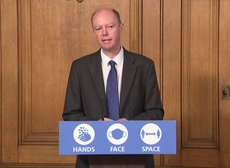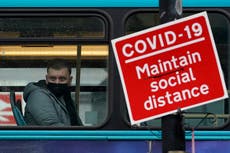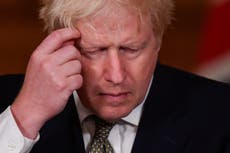Coronavirus: 'Very high' level restrictions not enough to reduce R rate below one, Sage adviser warns
Only Liverpool City Region is set to face most stringent local measures

Your support helps us to tell the story
From reproductive rights to climate change to Big Tech, The Independent is on the ground when the story is developing. Whether it's investigating the financials of Elon Musk's pro-Trump PAC or producing our latest documentary, 'The A Word', which shines a light on the American women fighting for reproductive rights, we know how important it is to parse out the facts from the messaging.
At such a critical moment in US history, we need reporters on the ground. Your donation allows us to keep sending journalists to speak to both sides of the story.
The Independent is trusted by Americans across the entire political spectrum. And unlike many other quality news outlets, we choose not to lock Americans out of our reporting and analysis with paywalls. We believe quality journalism should be available to everyone, paid for by those who can afford it.
Your support makes all the difference.Even the toughest coronavirus restrictions in the new three-tier system will not be enough to reduce the coronavirus R rate below one, a government scientific adviser has warned.
Professor Andrew Hayward from University College London said he thought it was “clear” these measures would not be sufficient to get the R rate – which represents the number of people one positive case goes on to infect – below that point.
His comments came after Boris Johnson announced a three-tier system of alert levels for England, which will see areas categorised as medium, high, or very high risk.
In the top tier – where currently only the Liverpool City Region is placed – social mixing will be banned both indoors and in private gardens, while pubs and bars will be told to close unless they can operate as a restaurant.
Local leaders will help to determine whether other venues should close, and residents will also be advised against travel in and out of the areas.
“Obviously the recent announcement is an attempt to simplify the advice through these tiers of systems," Prof Hayward, a member of the government’s Scientific Advisory Group for Emergencies (Sage), told the Today programme on Tuesday.
"But I think it is clear even at the very high levels of restriction, so-called, that those will not be sufficient to reduce R below one.”
On Monday, the government’s chief medical officer said he was “not confident” the top tier restrictions would not be enough to get on top of Covid-19 on their own.
Professor Chris Whitty said: “That is why there is a lot of flexibility in the tier three levels for local authorities guided by the directors of public health … to actually go up that range so that they can do significantly more than the base, because the base will not be sufficient."
Shortly after the UK prime minister announced the alert levels on Monday, a Sage document was published showing government advisers had recommended a short lockdown three weeks ago to tackle the spread of coronavirus.
“I think it is very disappointing we had clear advice that we needed to take decisive action several weeks ago," Professor Hayward said on Tuesday. "Since that time all we have really done is sent students back, introduced the rule of six, advised people to work from home if possible … and closed the pubs an hour early.”
The UCL professor of infectious disease epidemiology added: “So I think it is not really surprising that we are continuing to see large increases in cases, and that those increases are being seen around the country.”
The documents show Sage suggested immediately introducing a “circuit-break” lockdown lasting between two and three weeks to halt the rapid spread of the virus.
Downing Street insisted that "robust but targeted and proportionate" action had been taken in September, including the rule of six and the 10pm hospitality curfew.
MPs will debate and vote on the three-tier system on Tuesday and – if approved – it will come into effect on Wednesday.
One step down from very high risk, an area in the high level would mean household mixing is banned indoors, although support bubbles will still be permitted.





Join our commenting forum
Join thought-provoking conversations, follow other Independent readers and see their replies
Comments